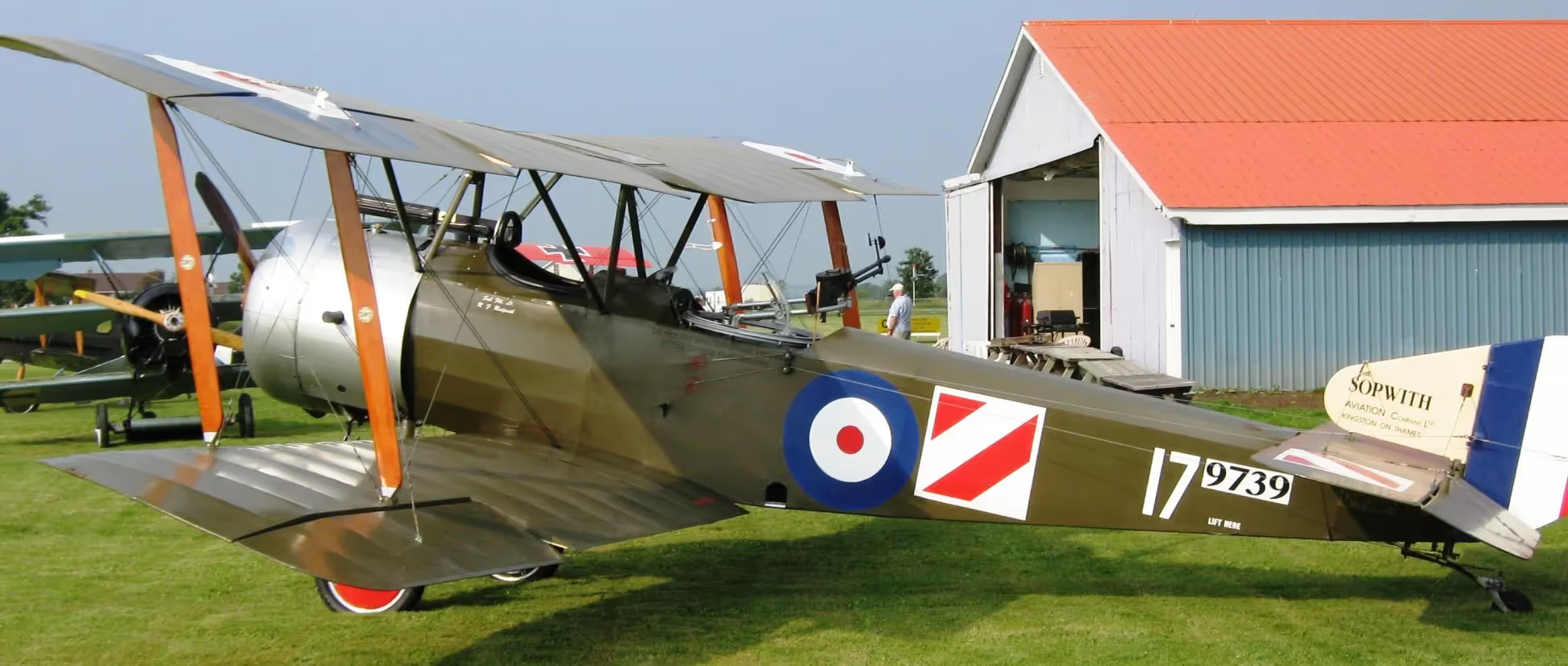Canadian Warplanes (5) Ontario, Caledon, The Great War Flying Museum (GWFM), Brampton Flying Club
Warplanes in Ontario
The aim of this website is to locate, identify and document all historical Warplanes preserved in Canada. Many contributors have assisted in the hunt for these aircraft to provide and update the data on this website. Photos are by the author unless otherwise credited. Any errors found here are by the author, and any additions, correctons or amendments to this list of Warplanes in Canada would be most welcome and may be e-mailed to the author at [email protected].
Caledon, The Great War Flying Museum (GWFM), Brampton Flying Club. Website: https://greatwarflyingmuseum.org/

(Rosariovan Tulpe Photo)
Fokker Dr.I. Luftwaffenmuseum der Bundeswehr; Airforce Museum of the Bundeswehr; Berlin-Gatow.
Fokker Dr.I replica (Serial No. 477/17), C-GFJK. Painted red, to represent a triplane as flown by Manfred von Richthofen, also known as the Red Baron, although it incorrectly wore the serial Fok. Dr I 103/17. In the winter of 2005 the aircraft was given all new fabric and repainted in more authentic colours to represent Fok. Dr I 477/17. |The museum chose to replicate the aircraft shown in photographs at Lechelle with the propeller wrapped in a tarp.

(Adrian Brooks Photo)


(Shawn Macdonald Photos)
Fokker Dr.I replica (Serial No. 204/17), C-GDRI.
Fokker D.VII replica (Serial No. 5324/18), C-GWWI, under repair. This Fokker DVII was the first aircraft built completely in house at the Great War Flying Museum. It was constructed using the same plan set as the replicas built for the film The Blue Max, except powered by an inverted Ranger engine rather than the Gypsy Queen. It was originally painted in the all white colours of Fok. D.VII 5125/18 as flown by Oblt Hermann Göering while in Jagdgeschwader I. In 1991 the aircraft was repainted complete with lozenge pattern to represent Hptm. Rudolf Berthold’s aircraft from Jadgdeschwader II bearing his winged sword insignia. This was briefly over-painted in the fall of 2003 while on the set of the film The Aviator(2003) so as to represent an all red D.VII from the film Hell’s Angels (1930). Once the temporary paint was removed the aircraft was returned to its red and blue Berthold colours. The 2007-2018 rebuild of the aircraft included complete recovering in lozenge fabric and applying the markings of Lt. d. R. Richard Kraut.

(USAAC Photo)
Fokker D.VII, ca 1918-1919, captured example being test flown by the US Air Service.

(Library and Archives Canada Photo, MIKAN No. 3214714)
Fokker D.VII with Major W.G. Barker, V.C. captured aircraft at Hounslow Aerodrome, UK, April 1919. (Library and Archives Canada Photo, MIKAN No. 3214714)

(Library and Archives Canada Photo, MIKAN No. 339044)
Fokker D. VII with Canadian Air Force markings, Maj A.E. McKeever, CO No. 1 Sqn, CAF, Upper Heyford, UK, 1919.

(Aldo Bidini Photo)
Nieuport 28C1 replica (Serial No. 6159), C-FEWL. This N28 replica is constructed of a welded steel fuselage with wood wings, and is powered by a Continental R670 radial. It is painted in the colours of the 94th Aero Squadron. The “Hat in the Ring” colours represent 6159 as flown by Eddie Rickenbacker.

(Library and Archives Canada Photo, MIKAN No. 3390895)
Royal Aircraft Factory S.E.5a.

(Aldo Bidini Photo)

(John Davies Photo)
Royal Aircraft Factory S.E.5a replica (Serial No. C1904), C-GRJC. The full scale SE5 was built to correspond to original Royal Aircraft Factory drawings, although the fuselage is actually of welded steel construction. Originally powered by a Ford truck engine running a propeller speed reduction unit, this was abandoned in favour of a Ranger aircraft engine. Only one paint scheme has been worn on this aircraft, C1904 as flown by William Avery Bishop, VC.

(Shawn Macdonald Photo)
Royal Aircraft Factory S.E.5a, 7/8 scale replica (Serial No. B4863), C-FQGM.

(RCAF Photo)
Sopwith 1½ Strutter, Ochey, France in March, 1917.

(Aldo Bidini Photo)


(Shawn Macdonald Photos)
Sopwith 1½ Strutter replica (Serial No. 9739), C-FSOP. This aircraft represents a two-seat fighter/observation aircraft. The Strutter is constructed with a steel fuselage, but externally conforms to original dimensions. The standard position for the rear seat is facing rearward so as to allow the gunner to operate the Scarff ring mounted Lewis gun, but it can also be turned around to allow for a more conventional forward facing seating position. Popular for film work due to its second seat, this aircraft significantly increases the ability of the museum to replicate scenes from World War One. It is currently painted to represent the colours of Strutter 9739 as flown by Flight Sub-Lt. R.F. Redpath of the Royal Naval Air Service.

(Library and Archives Canada Photo, MIKAN No. 3390976)
Sopwith F.1 Camel. being armed with bombs, No. 203 Sqn, Allonville, France, July 1918.
Sopwith F.1 Camel replica (Serial No. B6313), under construction, no registration.

2024, Canadian Warplanes II.





